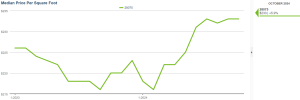The OP question was; what is that?
The better question; Whom developed, who owns?
Who we are

truefootage.tech
We've looked at them years ago on the Appraisers Blogs.
It's an idealist appraiser group whom invested the 50% split they keep from their cra's, to pay exorbitant six digit programmer salaries to come up with proprietary bedazzling software and lengthy nomenclature regarding the million different linear regression analysis details such as; least squares, thiel-sen, least absolute deviation, least median of squares, robust simple regression, modified quantile regression, best polynomial fits in scatter chart models, etc, etc.
You know, the mathematical approach that absolutely NOBODY whom purchases or sells houses pays attention to. That's how we can know the appraisers whom use such software are smarter than regular market participators because they use advanced methods nobody else does.
Then because the appraiser is using such apparently advanced technology which the laymen desk reviewers simply do not understand, they seem really really smart and stuff. This gives the appraiser the newfound intellectual authority to make the appropriate judgment to determine due to an excess of data, if a bed or bath adjustment should be at the low range of $2k or the high of $25k, that sort of thing.
It's quite similar to WAGS wild *** guesses, or throwing darts, but now with interesting square chart graphics and hyperbolic trigonometry and calculus language.
I can look at a single page of one line market overview data and tell you the exact same thing by simply looking at high low price margins and doing simple extraction with pen scribbles on MLS print out pages. Or draw up a similar XY chart with a pen and paper, plotting the dots and drawing a line where the dots appear.
Then the appraiser needs to look really serious and reflective, put his fist on his chin in classic intellectual pose, take his glasses off, chew on the end of the desk pencil, appear stressed for a moment, then shout Eureka! The valid per bath room adjustment is right here!
That's when they draw a little square around the dots and lines indicating that's the range they wish to adjust at, and fill out the little data entry box below. They have now 'proved the adjustment' to completely inadequately qualified review people whom are not qualified to do basic math or report reading themselves. It's like an appraisal ropa dope, you've got to bedazzle them with data then shift off the ropes for a knock out punch to avoid stipulation kickback. You can't hit what you can't see, and they can't question what they don't understand in the first place.
________________________________________________
Regression tool dependent appraisers miss the mark every last time because the ranges are absurd because the data set sizes needed to populate that many dots on a graph are quite often beyond the reasonable more limited market ranges one ends up with, when they apply simple size of home, age of home, location of home range limitations, and type of home MLS research filtration to the sales data. But you can't look all smart with these charts and graphs, if you've taken the time to engage in thoughtful logical research and only have a dozen or two realistic sales comparisons to choose from. Nope, you need the whole damned zip code or multiple neighborhood sets to populate those charts. Nobody is going to be impressed by a line drawn through an XY chart which only has three dots on it because you took the time to actually sort out the best sales examples. And that's where the absurd ranges come from with $20k+ or more 'possible adjustment indicator' margins. Where as if you had a more limited pointed data set, you'd need less adjustments because all your comps are more similar to each other! This is how data cancer happens, the use of regression analysis which can systemically stack an excess or dearth of adjustable volume into price and value output. It's the 'on paper' argument. In the real world if we do not select individual comps from outside neighborhoods and non competing dis similar housing bodies, so why in the hell do people think it's a good idea to extract your adjustments from that overly broad data set? Yeah they're 'market derived' but the fundamental logical shortfall which is not asked; 'but from which market?' That's the summary argument against regression.
On top of that they forget the basic rules of order of operations, that you don't want to deal with that data extraction, until you've already subtracted the land, sorted dis similar out of the data pool, qualified data and kicked out the skewed or outlier instances, adjusted out substantial items like pools, decks, views, and then after all that is done, you cut to quick work of averaging out some ppsf adjusts or much more simple approach of logically interpreting reasonable bed bath and other adjusts based on your indicated adjusted value lines, to see if there is a streamlined result to determine if you've successfully identified the local markets value benchmarks or not. Because if you cut right to the extracted bed/bath without the other data cleanup first, you end up with an excessive indicator. You can spot people whom don't actually know what they're doing, the ones whom rely on the automation, a mile away. Their adjusted sales values indicators will not be streamlined so they'll use 9, 12 or more comps quite often, until one of them finally adjust out the way they think it should, and they'll scoot those to front priority and 'weight them'. If you're doing it right you don't need to weight anything as long as market benchmarks are consistent. Your final value opinion is a simple expression of a straight average of adjusted value indicators. And if you know what you're doing, you purposefully avoid overly complex data in favor of simple more easy to interpret more narrowly focused data which a regular person whom does not buy into proprietary software can understand.
The most simple boiled down summary of the debacle which is institutionalized regression analysis demands for individual sales analysis is this; If you can't do the job yourself with a pen and a piece of paper, a limited data set of only local sales, you're doing it wrong. I always make sure to post my one line final data sets in the reports. Then if whomever wants to waste their time running all that through their pointless programs, they are free to do so. They'll waste a lot of time, pay a lot of money, accomplishing the same thing I did with an old laserjet printer and a basic MLS and bare bones basic appraisal software subscription, applying thoughtful data filters as I spend an hour or two forming a defensible workfile. They're not leaving themselves liability outs and one could only guess if challenged outside of their pay to play environment, if they could really honestly describe the advanced calculation and development proceedures they're actually relying on. It's called mini math for appraisers and if you can't simplify the data in the first place, you don't know what the hell you're doing. Efficiency has limits and these people have clearly gone past that. The wild part is we're just getting started with systemic data cancer and comparative irregularities where skewed outliers and improperly sourced data is now injected into the process, and people have only been using this technology to this degree for a few years now. Show me on paper. Take this MLS data set. Show me with a pen and paper how you do that again, no software allowed. Because if you understood the method you'd understand you can accomplish the same thing without the $400 a year proprietary software subscription, and use some free excell program or graph paper instead to come up with the exact same thing, only better. That's why I skip the whole process, feed the raw data into my reports, and let them do what they may with it. But now and then I will be so kind as to itemize my exact ppsf, land ppsf, bed, bath, age, and other adjusts in a quick blurb to make reviewers lives easier. How to avoid stips and kickback 101, stop making the process overly complicated. Don't pretend to be a math genius. Provide reports everyone can understand. Save your money on these software gimmicks.
___________________________________________________





